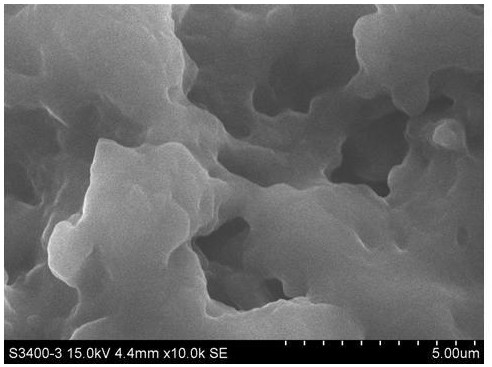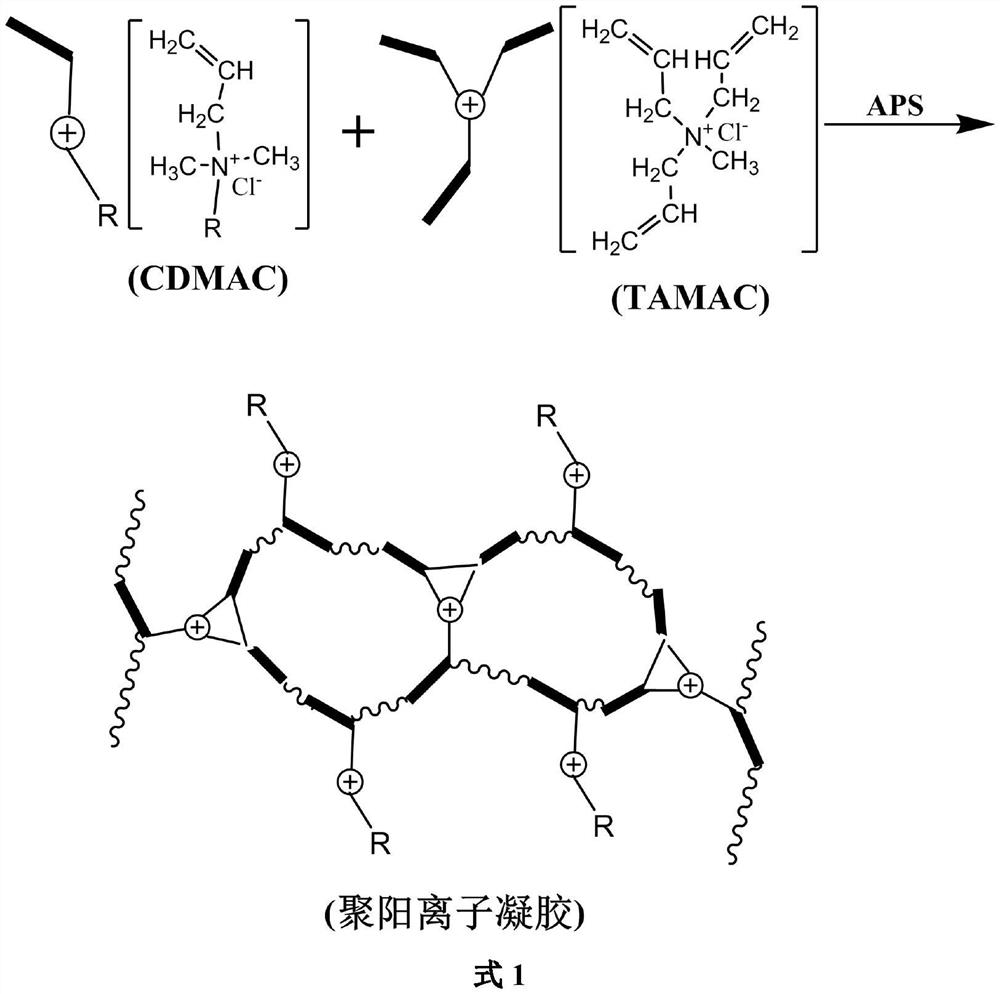A kind of preparation method of porous polyquaternium salt gel adsorbent
A polyquaternary ammonium salt and adsorbent technology, which is applied in chemical instruments and methods, adsorption water/sewage treatment, and other chemical processes, can solve the problems of printing and dyeing wastewater adsorption and decolorization, achieve strong adsorption and capture capabilities, and improve reaction efficiency Effect
- Summary
- Abstract
- Description
- Claims
- Application Information
AI Technical Summary
Problems solved by technology
Method used
Image
Examples
Embodiment 1
[0025] Step 1: Take the measured cross-linking quaternary ammonium salt monomer TAMAC and the large molecular volume quaternary ammonium salt monomer CDMAAC [the molar ratio of the two monomers is n (TAMAC) / n (CDMAC) =95 / 5] join in the reactor that reflux condensing device is housed and be made into the reaction solution that initial monomer solution mass fraction is 55%;
[0026] Step 2: Weigh the initiator ammonium persulfate APS accounting for 1% of the total monomer mass (the sum of TAMAC and CDMAC mass), add it to the reaction solution, stir and mix evenly;
[0027] Step 3: First pass through the three-way ventilation system, with inert protective gas N 2 Replace the air in the reaction system, and then add N 2 The introduction tube is inserted into the reaction mixture for bubbling, and under mechanical stirring, the temperature is raised to 50°C for bubbling cross-linking copolymerization reaction for 0.5h, and the reaction material is viscous and flowing;
[0028]...
Embodiment 2
[0033] Step 1: Take the measured cross-linking quaternary ammonium salt monomer TAMAC and the large molecular volume quaternary ammonium salt monomer CDMAAC [the molar ratio of the two monomers is n (TAMAC) / n (CDMAC) =50 / 50] join in the reactor that reflux condensing device is housed and be made into the reaction solution that initial monomer solution mass fraction is 60%;
[0034] Step: 2: take by weighing the initiator ammonium persulfate APS accounting for 2% of the total monomer mass (TAMAC and CDMAC mass sum), join in the reaction solution, stir and mix;
[0035] Step 3: First pass through the three-way ventilation system, with inert protective gas N 2 Replace the air in the reaction system, and then add N 2 The introduction tube is inserted into the reaction mixture for bubbling, and under mechanical stirring, the temperature is raised to 50-55°C for bubbling cross-linking copolymerization reaction for 1.0h, and the reaction material is viscous and flowing;
[0036] ...
Embodiment 3
[0041] Step 1: Take the measured cross-linking quaternary ammonium salt monomer TAMAC and the large molecular volume quaternary ammonium salt monomer CDMAC [the molar ratio of the two monomers is n(TAMAC) / n(CDMAC)=5 / 95] and join in In the reactor equipped with reflux condensing device and be made into the reaction solution that initial monomer solution mass fraction is 65%;
[0042] Step 2: Weigh the initiator ammonium persulfate APS accounting for 1-3% of the total monomer mass (the sum of TAMAC and CDMAC mass), add it to the reaction solution, stir and mix evenly;
[0043] Step 3: First pass through the three-way ventilation system, with inert protective gas N 2 Replace the air in the reaction system, and then add N 2 The introduction tube is inserted into the reaction mixture for bubbling, and under mechanical stirring, the temperature is raised to 55°C for bubbling cross-linking copolymerization reaction for 1.0h, and the reaction material is viscous and flowing;
[0044...
PUM
 Login to View More
Login to View More Abstract
Description
Claims
Application Information
 Login to View More
Login to View More - R&D
- Intellectual Property
- Life Sciences
- Materials
- Tech Scout
- Unparalleled Data Quality
- Higher Quality Content
- 60% Fewer Hallucinations
Browse by: Latest US Patents, China's latest patents, Technical Efficacy Thesaurus, Application Domain, Technology Topic, Popular Technical Reports.
© 2025 PatSnap. All rights reserved.Legal|Privacy policy|Modern Slavery Act Transparency Statement|Sitemap|About US| Contact US: help@patsnap.com


